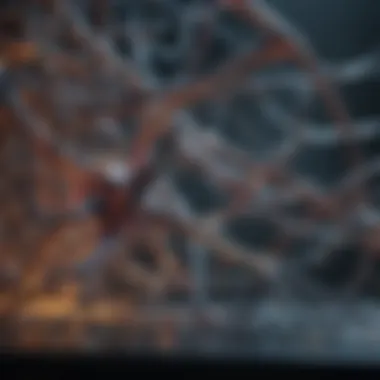Exploring the Cascade Web: Structure and Implications


Intro
The cascade web is an increasingly important concept in the realm of scientific exploration. It represents the intricate relationships between different scientific disciplines and their combined research outputs. Understanding these connections is essential as they facilitate knowledge sharing and promote interdisciplinary collaboration. This article aims to dissect the cascade web, discussing its structure and implications for the scientific community.
Research Highlights
Overview of Key Findings
In investigating the cascade web, key findings illustrate how disciplines like biology, chemistry, physics, and earth sciences interconnect. The interdependence among these fields leads to a richer understanding of complex problems. Researchers are discovering that significant advancements in one domain can cascade into another, enhancing the overall knowledge base.
Significance of the Research
Understanding the cascade web has profound implications for scientific research and collaboration. It emphasizes the importance of a multifaceted approach to problem-solving, enabling researchers to draw on diverse perspectives. This interconnectedness can lead to innovative solutions that may not emerge within isolated domains.
"The cascade web transforms how research is conducted, making interdisciplinary collaboration essential for addressing contemporary challenges in science."
Integrating Knowledge
Enhancing Collaboration
By recognizing the structure of the cascade web, researchers can enhance collaboration across disciplines. Key strategies involve:
- Creating interdisciplinary teams that actively engage in projects across various fields.
- Facilitating workshops and conferences focused on cross-disciplinary topics.
- Utilizing data visualization tools to showcase interconnected research outcomes.
Data Visualization and Technology
Advancements in technology play a critical role in understanding the cascade web. Sophisticated data visualization tools enable researchers to analyze complex networks more effectively. These tools reveal patterns and relationships that may be obscured in traditional research formats. Researchers can utilize software such as Gephi or Cytoscape for this purpose, creating visual representations that aid understanding.
Implications for Future Research
The ongoing evolution of scientific communication and collaboration is influenced by the cascade web. As this framework becomes more established, future research may focus on:
- Exploring the dynamics of collaboration in real-time.
- Evaluating the effectiveness of interdisciplinary research efforts.
- Identifying new opportunities for cross-disciplinary innovations.
Through these approaches, the scientific community can cultivate a more integrated understanding of multifaceted issues, paving the way for breakthroughs that benefit society.
The End
This exploration of the cascade web highlights the necessity for scientists to embrace interdisciplinary connections. As knowledge becomes increasingly interconnected, it fuels innovations that might not have been achievable within isolated disciplines. The implications for collaboration and knowledge sharing are vast, enhancing the potential for impactful scientific discoveries. Future research must continue to navigate this web, ensuring that the relationships between scientific disciplines thrive.
Prelims to the Cascade Web
The cascade web represents a pivotal concept that provides insight into the intricate relationships among various scientific disciplines. Understanding this framework is essential, as it emphasizes the interconnectedness of research outputs across different fields. This interconnectedness facilitates a diverse flow of information, which is critical for advancing scientific inquiry. By investigating the cascade web, scholars and researchers can better navigate the complex landscape of knowledge dissemination, enabling more effective collaboration and innovation.
Definition and Conceptual Overview
The cascade web can be defined as a network of connections that illustrates how research findings and ideas flow between different areas of scientific inquiry. At its core, the cascade web consists of nodes and edges that represent the interdependencies among disciplines. Each node signifies a specific research output, such as a journal article or conference paper, while the edges represent the citation and referencing relationships between these outputs. This structure not only serves as a visualization of knowledge transfer but also highlights the pathways through which ideas evolve and influence each other.
One key aspect of the cascade web is its dynamic nature. As new research is published, the network expands and evolves, leading to shifts in how information is prioritized and accessed. The cascade web's adaptability allows for the examination of emerging trends and the identification of influential research that could pave the way for breakthroughs across various fields.
Historical Context of Cascading Networks
The concept of cascading networks has its roots in the study of complex systems and network theory. Historically, researchers began to recognize the significance of interdisciplinary connections, particularly in the wake of the rapid advancements in technology and communication over the past few decades. These developments have enabled researchers to access and share information more efficiently than ever before.
In the early days of scientific inquiry, disciplinary silos were prominent, with little exchange of ideas across fields. However, the advent of digital platforms has transformed this landscape. Now, research outputs can be disseminated globally, fostering collaboration that transcends traditional boundaries. This shift marks a significant evolution—transforming isolated academic pursuits into interconnected fields of study that contribute collectively to knowledge.
By analyzing the historical context of cascading networks, we notice a shift in how scholarly communication occurs. This evolution highlights the importance of understanding these relationships in the present-day context, where collaboration and amalgamation of knowledge are fundamental to scientific progress.


The Structure of the Cascade Web
Understanding the structure of the cascade web is fundamental for comprehending how scientific disciplines interconnect and influence research outputs. The cascade web represents more than mere relationships; it exemplifies a framework that delineates the flow of knowledge and information within and between various academic fields. By analyzing its structure, one can appreciate the dynamics that govern the exchange of ideas and methodologies, ultimately impacting scientific progress and collaboration.
Node and Edge Dynamics
In the context of the cascade web, nodes represent the different elements or entities within this network, while edges signify the connections between them. Each node can be a research paper, a scientific institution, or an individual researcher. The edges indicate citations, collaborations, or references that exist among these nodes.
The dynamics between nodes and edges are crucial. They illustrate how ideas propagate through the network. A highly-cited article, for example, can have many edges pointing to it, showing a significant influence on surrounding research. Conversely, nodes with fewer connections may indicate isolated studies that, while perhaps valuable, do not engage with the broader scientific dialogue.
To better visualize this, one could consider:
- Central Nodes: These are hubs that connect vast portions of the network, often representing well-established theories or landmark studies.
- Peripheral Nodes: These represent niche research areas with limited connections, potentially richer for innovative breakthroughs but risk being overlooked.
Examining the dynamic interactions between these nodes can help researchers identify emerging trends and gaps in knowledge. Furthermore, understanding how information flows along the edges allows scholars to trace back the lineage of theories and concepts, providing a comprehensive view of the scientific evolution.
Types of Cascading Networks
Cascading networks can be categorized in various ways, each presenting unique characteristics and implications for scientific collaboration. Below are several prominent types:
- Disciplinary Networks: These focus on relationships within a specific field, such as biology or physics. They enable experts to connect deeply with peers in their discipline.
- Interdisciplinary Networks: These involve collaboration across different fields. For example, the intersection of biology and computer science in bioinformatics represents a growing interdisciplinary network. This type of network facilitates innovative solutions by merging distinct perspectives.
- Collaborative Networks: These networks highlight joint research efforts among multiple institutions or researchers. They are crucial for large-scale projects, such as those seen in climate science or public health, where varied expertise is necessary.
- Online Networks: With the rise of digital platforms, online networks have become prominent. ResearchGate or academia.edu offer spaces for researchers to share, discuss, and critique work, transforming how ideas are disseminated.
Each of these network types carries implications for how knowledge is shared, influencing the pace and direction of research. By dissecting these structures, stakeholders can make informed decisions about collaboration, funding, and research priorities, ultimately enhancing productivity and innovation in science.
"The structure of the cascade web serves as both a map and a compass for researchers navigating their fields."
Interdisciplinary Connections
In the context of the cascade web, interdisciplinary connections refer to how different scientific fields interact and influence each other through shared knowledge, methodologies, and techniques. This interaction is crucial for advancing research, as it encourages collaboration across disciplines, leading to innovative approaches and solutions. The complexities of modern science necessitate that researchers draw from various areas of expertise to address multifaceted problems, so understanding these connections is paramount.
Flow of Information Among Fields
The flow of information among fields in the cascade web plays a significant role in fostering new ideas and enhancing productivity. Information can travel seamlessly across disciplines, meaning that breakthroughs in one area can inspire work in another. For instance, developments in computational biology can influence advancements in genetics and data science. Researchers benefit from diverse perspectives when they access findings generated in other domains.
Some key aspects to consider include:
- Cross-disciplinary Communication: This involves online platforms, conferences, and collaborative projects that promote dialogue between experts from varying fields. It is essential for establishing networks that enhance knowledge sharing.
- Access to Varied Methodologies: Different disciplines often employ unique methodologies. By drawing from multiple approaches, researchers can devise innovative solutions that may otherwise not emerge in a siloed environment.
- Increased Visibility: When research is shared across disciplines, it widens the audience and increases the impact. This visibility can attract funding or enhance reputability among peers.
"The convergence of scientific research fields promotes a richer understanding of complex questions, driving forward innovation and discovery."
The effective flow of information among disciplines depends heavily on the use of collaborative technologies. Tools such as ResearchGate and social media platforms like Facebook help researchers to stay connected. These resources facilitate the sharing of results, discussions, and methodologies, creating a dynamic network where ideas flourish.
Impact on Collaborative Research
Collaborative research in the context of the cascade web reshapes how scientific endeavors are undertaken. As disciplines converge, researchers find themselves working in teams that combine their unique skills and knowledge.
The benefits of collaborative research are significant:
- Diverse Expertise: Teams comprised of individuals from various backgrounds can tackle challenges more effectively. This diversity allows for innovative problem-solving approaches, which can lead to ground-breaking discoveries.
- Resource Sharing: Collaborations often lead to shared resources, such as facilities, funding, and data. This can reduce costs and expedite research processes.
- Expanded Networks: Researchers involved in interdisciplinary collaborations enhance their professional networks, which can lead to further opportunities for joint projects, mentorship, and increased recognition in their respective fields.
- New Perspectives: Interdisciplinary efforts encourage researchers to step beyond their traditional boundaries, minimizing tunnel vision. This increased exposure results in a comprehensive approach to research questions that better reflect the complexity of real-world issues.
Scholars and professionals should recognize these connections as crucial to the evolving landscape of scientific research. Understanding the intricate web of interactions between disciplines enhances the potential for collaborative success, pointing towards a more integrated method of inquiry.
Functionality of the Cascade Web
Understanding the functionality of the Cascade Web is essential for grasping how scientific knowledge spreads across various disciplines. This network provides a framework for connecting researchers, ideas, and findings. The Cascade Web supports the exchange of information, allowing for collaborative research efforts that enhance the scientific process. When examining functionality, it's vital to focus on two main elements: mechanisms of knowledge dissemination and the role of peer review in networking.
Mechanisms of Knowledge Dissemination
The dissemination of knowledge within the Cascade Web operates through several interconnected mechanisms. These mechanisms influence how information travels through the network and how it is utilized by researchers across disciplines.


- Interdisciplinary Communication: The communication between different scientific fields creates a diverse knowledge pool. Researchers from biology, chemistry, and physics, for instance, can share insights that drive innovation.
- Publications and Citations: Academic publications serve as the primary medium for knowledge dissemination. Each published paper can lead to countless citations, broadening its reach. The impact factor of journals plays a significant role in determining the visibility of work.
- Conferences and Workshops: In-person and virtual gatherings facilitate the exchange of ideas. Presentations and discussions at these events allow researchers to showcase their work and inspire others.
- Networking Platforms: Online platforms, such as ResearchGate and Academia.edu, allow researchers to connect and share resources easily. These platforms encourage collaboration and foster discussions that advance knowledge.
The flow of information is not always linear. Instead, it resembles a web where nodes represent ideas, and edges represent connections. This structure allows for fluid movement of concepts, making it easier to identify gaps or opportunities for further research.
Role of Peer Review in Networking
The peer review process is a cornerstone of academic integrity and plays a crucial role in the functionality of the Cascade Web. This process ensures that the research being circulated has been evaluated by experts in the field before dissemination. Several key points illustrate its importance:
- Quality Control: Peer review maintains the quality of published research. Reviewers scrutinize methodologies and conclusions, ensuring that only robust studies reach the public domain.
- Credibility Enhancement: When research receives positive peer reviews, it enhances the credibility of the authors. This trust can lead to increased collaboration and networking opportunities.
- Constructive Feedback: The peer review process not only assesses work but also provides constructive feedback. Authors can refine their research, thus improving future contributions to the Cascade Web.
- Identification of Emerging Trends: Peer-reviewed publications often highlight emerging trends and gaps in knowledge. This can lead to new avenues for research and collaboration among scientists.
In summary, the functionality of the Cascade Web is contingent upon effective mechanisms for knowledge dissemination. The role played by peer review within this framework cannot be overstated. Both contribute significantly to the advancement of science, enhancing collaboration and fostering innovation across disciplines.
Implications for Scientific Research
The implications for scientific research within the context of the cascade web are significant. Understanding how knowledge flows among various academic and scientific fields can provide essential insights into the dynamics of research trends and methodologies. The cascade web acts as a framework for examining the relationships between different disciplines, revealing how insights from one area can influence and catalyze advancements in others. This interconnectedness has several benefits, which are crucial for researchers and institutions alike.
First, the cascade web highlights the interdependence of various branches of scientific inquiry. For example, breakthroughs in biology can often impact the fields of chemistry or physics. This cross-discipline relationship fosters innovation, encourages collaboration, and leads to novel discoveries. Eventually, this synergy can accelerate the pace of research and broaden the scope of inquiry, reflecting more comprehensive views of scientific phenomena.
Additionally, by mapping these connections, researchers can identify trends that might not be visible in isolated studies. Such insights allow for more nuanced understanding of emerging areas of research, guiding funding allocation and resource distribution effectively. Academic institutions can utilize these findings to prioritize collaborative projects, optimizing their potential for impact.
Finally, awareness of the implications of the cascade web can help ensure that knowledge dissemination is not siloed within disciplines. Uniting diverse scholarly efforts can lead to more robust approaches to addressing complex societal issues that require interdisciplinary solutions. An environment that promotes collaborative research is vital for fostering sustainable development and preparing for future challenges.
Influence on Research Trends
The influence of the cascade web on research trends is evident as it shapes how scholars and practitioners investigate scientific questions. When looking closely, it becomes apparent that the characteristics of the cascade web leave their mark on publication patterns, citation practices, and collaborative efforts. The flow of knowledge encourages a shift from single-discipline studies to interdisciplinary approaches, which align with the modern scientific landscape.
Research trends influenced by the cascade web typically exhibit the following features:
- Increased Collaboration: Teams containing diverse expertise often yield richer perspectives, enhancing problem-solving methods.
- Indexing of Citations: The interconnected nature of updates in scientific literature offers a better idea of which areas are experiencing growth or decline in interest.
- Emergence of Hybrid Topics: Topics that span multiple disciplines, such as bioinformatics or environmental chemistry, signify a significant trend due to the flow of knowledge.
Potential for Innovation and Discovery
The cascade web has great potential for spurring innovation and discovery across scientific realms. A primary driver behind this potential is the ability to connect distinct ideas and methodologies. As researchers share and exchange knowledge, ideas from one discipline can be adapted, modified, or combined with others, leading to novel applications and breakthroughs.
Consider a few notable aspects:
- Enabling Open Innovation: The cascade structure allows different entities—ranging from universities to private sector companies— to collaborate, sharing insights that can lead to unexpected innovations.
- Fostering Ecosystems of Discovery: Institutions that leverage the cascade web can build environments where diverse scientific dialogue thrives, encouraging exploratory research that may not fit traditional research paradigms.
- Enhanced Access to Resources: With increased interconnectivity, researchers can tap into a wider array of data and methodologies, fostering a more resourceful movement toward innovation.
This interconnected web not only emphasizes the relationships among scientific fields but also serves as a platform for collective intelligence, making way for impactful discoveries that move beyond conventional boundaries.
Data Visualization in the Cascade Web
Data visualization in the cascade web holds significant importance for comprehending the intricate connections across scientific disciplines. This network, rich with data and research output, benefits immensely from visual representations. They provide clarity, facilitate understanding, and enable pattern recognition among complex datasets. Visual tools transform data into comprehensible formats, making essential information accessible to a wider audience, including students, researchers, and educators.
Emerging Tools and Technologies
Advancements in technology have led to the development of various tools that assist in visualizing cascade networks. Tools such as Cytoscape, Gephi, and D3.js allow researchers to create interactive and dynamic representations of data.
- Cytoscape is primarily used for visualizing molecular interaction networks. It provides an open-source platform for bioinformatics and complex network analysis.
- Gephi focuses on exploring and analyzing large networks. This tool enables data scientists to visualize structures and detect patterns, crucial for understanding the cascade web's dynamics.
- D3.js is a powerful JavaScript library for producing sophisticated visualizations in web browsers. By utilizing HTML, SVG, and CSS, it allows users to bind data to the Document Object Model (DOM) and apply data-driven transformations to the document. The flexibility and customization offered by D3.js make it a preferred choice for researchers.
These tools not only enhance the aesthetic quality of visualizations but also improve the interpretability of the data, promoting a better understanding of research connections in the cascade web.
Best Practices for Representation
To ensure effective data visualization, certain best practices should be followed when representing information within the cascade web. A few guidelines include:
- Clarity: Aim for simplicity and clarity. Reduce clutter by focusing on essential data points and avoiding excessive text.
- Consistency: Use consistent colors, shapes, and styles for similar data types. This helps in identifying patterns easily.
- Annotation: Provide clear labels and legends. This allows viewers to understand what the visualization represents without confusion.
- Interactivity: Integrate interactive elements where possible. Users should have the ability to drill down into data for a deeper exploration of the cascade web's intricacies.
- Feedback: Solicit feedback from peers and target audiences regarding visual representations. This will identify areas for improvement and enhance overall effectiveness.
Data visualization is an evolving field within the context of the cascade web. Effective representation of information not only helps in understanding complex interconnections among scientific disciplines but also catalyzes collaboration among researchers. By implementing advanced tools and adhering to best practices, the cascade web can be more thoroughly explored and understood.


Challenges in the Cascade Web
In the framework of cascading networks, understanding the challenges is essential for optimizing knowledge flow and research collaboration among varied scientific domains. The multitude of interconnections within the cascade web creates both opportunities and obstacles. The ability to navigate these difficulties plays a significant role in shaping the future of scientific inquiry and research practices.
Information Overload and Filtering
One of the most pressing issues within the cascade web is information overload. With vast amounts of data being generated across scientific disciplines, researchers often find themselves inundated with excessive information. The sheer volume of publications, studies, and data sets can lead to confusion and a paralysis of choice. In such an environment, the challenge lies in filtering relevant content from the noise.
To combat this problem, effective strategies for filtering information must be implemented. Here are some essential approaches for managing information overload:
- Utilizing Advanced Search Tools: Many databases now offer advanced searching capabilities that allow users to hone in on specific keywords or relevant studies efficiently. Tools such as Google Scholar or PubMed can help refine searches.
- Research Management Software: Programs like Zotero and Mendeley aid researchers in organizing references and access to relevant materials. These tools can streamline the research process, making it easier to track sources and stay current.
- Peer Networks: Collaborating with colleagues and forming peer groups can significantly reduce the time spent finding reliable information and interpreting data. This collective approach promotes shared knowledge and productive dialogue.
Utilizing these strategies can minimize the effect of information overload, enhancing clarity in the cascade web.
Accessibility and Equity in Research
Accessibility remains a critical concern in the context of the cascade web. Not all researchers have equal access to academic resources, particularly in underfunded disciplines or institutions. Factors such as geographical location, institutional support, and funding disparities can create an uneven playing field in the quest for knowledge dissemination.
Considered effective strategies for enhancing accessibility include:
- Open Access Journals: Promoting and publishing research in open access platforms mitigates barriers to information, allowing broader audience reach and increased citations.
- Funding for Infrastructure: Providing grants to institutions in developing regions can foster equity and support local research initiatives. Ensuring that funding bodies prioritize equity in research allocation could strengthen academic contributions.
- Technology and Training: Training programs that equip researchers with technology skills to access and utilize online resources can significantly improve research equity benefitting talent across various backgrounds.
These strategies can foster an environment of inclusivity and collaboration, ensuring the cascade web serves the greater scientific community.
The cascade web emphasizes interconnectedness, but without addressing information overload and accessibility, its full potential cannot be realized.
Future Directions in Cascade Networks
The exploration of future directions in cascade networks is vital for understanding how scientific research can evolve. As disciplines become increasingly intertwined, recognizing the implications for collaboration and technological enhancement allows researchers to anticipate greater innovations and efficiency in knowledge sharing.
Anticipated Trends in Research Collaboration
Collaboration across different scientific fields is expected to become more dynamic. As researchers face complex problems that cut across traditional disciplinary boundaries, interdisciplinary teams are developing. These trends manifest through:
- Increased Academic Partnerships: Universities and research institutions are forming strategic alliances to share resources and insights. This practice enhances productivity and fosters innovative solutions.
- Global Collaboratives: International partnerships are rising in number. Projects like the Human Genome Project showcase how a global perspective can accelerate scientific breakthroughs.
- Community Engagement: Researchers are integrating public input into their projects, enhancing the relevance and applicability of their work. For example, crowdsourcing data will play an important role in various fields, from social sciences to environmental studies.
Understanding these trends signifies the potential to enhance research output and quality. As networks of knowledge grow denser, the need for effective communication and collaboration tools will become paramount.
Technological Advancements and Their Effects
Technological advancements will play a transformative role in cascade networks. The development of tools and platforms for collaboration is accelerating. Some key advancements include:
- Artificial Intelligence Integration: AI can streamline research by automating data analysis, thus freeing up researchers to focus on critical thinking and innovation. AI-driven algorithms may also identify patterns in data that were previously unseen.
- Improved Data Sharing Platforms: Technologies enabling seamless data sharing, like GitHub, allow researchers to share findings and collaborate in real-time. This not only accelerates research but also enhances transparency in the scientific process.
- Remote Collaboration Tools: Video conferencing and project management platforms, such as Zoom and Trello, are essential for remote teams. These tools facilitate ongoing communication and collaborative planning regardless of geographical distance.
The ongoing evolution of digital tools fosters an environment where researchers can innovate and iterate more efficiently. As these technologies continue to advance, they will greatly influence how knowledge is created and distributed in the cascade web.
The interplay between collaboration and technological growth represents a shift in the scientific paradigm, where boundaries of disciplines blur and communication becomes more fluid.
End: The Evolving Landscape of the Cascade Web
The conclusion of this article cements the significant role of the cascade web in shaping modern scientific inquiry and communication. As discussed in earlier sections, the cascade web serves not only as a structural framework but also as a dynamic entity that facilitates knowledge exchange across disciplines. Understanding its evolving nature is crucial for researchers and educators who seek to leverage its potential in fostering collaboration.
Summary of Key Insights
Throughout this article, we have explored several facets of the cascade web:
- Structure: The intricate dynamics of nodes and edges establish the foundation of cascading networks, revealing how information propagates across different fields.
- Functionality: The mechanisms for knowledge dissemination and the role of peer review underscore the importance of maintaining rigor in research practices.
- Implications: The cascade web significantly influences research trends and stimulates innovation by allowing diverse fields to interact and share breakthroughs.
- Challenges: Issues such as information overload can threaten the efficiency of this network, thus necessitating effective filtering mechanisms.
- Future Directions: Anticipated advancements in technology promise to enhance collaborative efforts, potentially reshaping the landscape of scientific inquiry.
In summary, the cascade web exemplifies the interconnected nature of scientific research, fostering a culture of collaboration that extends beyond traditional boundaries.
Calls for Further Research and Exploration
To fully harness the potential of the cascade web, further investigation is imperative. Specific areas that warrant deeper analysis include:
- New Methodologies: Developing advanced tools for data visualization and network analysis can enhance comprehension of the cascade web’s complexity.
- Accessibility: Research can focus on improving access to information within the cascade web, ensuring that all researchers can participate equally.
- Interdisciplinary Studies: Encouraging studies that bridge gaps between disparate fields may yield unexpected insights and drive cross-pollination of ideas.
- Longitudinal Studies: Investigating changes in the cascade web over time can provide beneficial insights into how scientific fields evolve and adapt.







